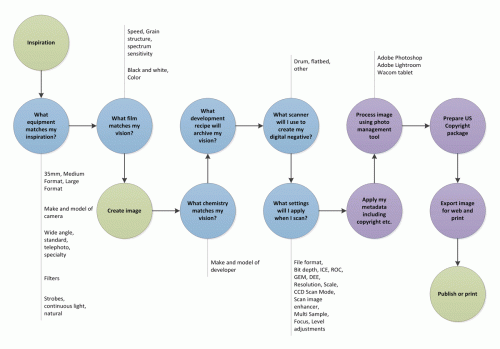Over a year has past and our new studio is nearly complete, we have a new addition to the family – a baby daughter – and my desire to photograph has never been stronger. Over the last year I have been thinking about hybrid photo workflow and realized I have yet to come to the end of the flow, where the work goes beyond the digital world and returns to the analog in the form of a print. Of course I have sent images off to be printed at places like myPhotopipe. For example, I got some samples done of the Gilchrist No. 22 and was impressed with the results, but ultimately have very little to compare with. The November / December issue of View Camera has my head spinning on the topic of black and white photograph inkjet printing.
Given a basic hybrid photo workflow, we start with inspiration, select equipment that has some synergy with the burning thought and capture the image to film. We make some more decisions about the analog to digital conversion – selecting a film developer to which settings to apply while scanning. Finally we manage the new asset and export it for the web or print. Its this last step that I have been so dull on.
Photo technique magazine has had a great series of articles that got me thinking about how part of the hybrid photo journey is going to have to deal with the print – and there are so many options! There is everything from turning the digital image into a negative and doing traditional wet prints, to alternative processes to digital chromogenic prints to inkjet. Then you realize on the last one – inkjet – there are even more ways to craft the print!
The Modern Alchemist: Collodio-Chloride Printing-Out Paper, Bill Westheimer, November/December 2011The Artisan Approach to Inkjet Printing, Wendy Erickson, January/February 2011Creating Digital Paper Negatives by Chris Woodhouse, March/April 2010Chromoskedasic Printing by Christina Z. Anderson, May/June 2010
There is of course the injet substrate decision – is it going to be a canvas or Hahnemühle photo rag or some other destination? Are you printing or are you sending it out to someone else? Good printers can be expensive, not to mention the inks and papers and the likely spoilage of these consumables. If you send it out will they get what you are looking to do or is it fire and forget.
The November / December 2011 issue of View Camera showcases an article by Jon Cone, The State of the Art in Black and White Inkjet Printing. A form of that content appears to also be available at The Agnostic Print. What you learn is that Piezography K7 rocks Epson’s Ultrachrome K3 inks. Its not even a close call. So those photo finishing houses offering you an expensive black and white print on Hahnemuhle are giving you less than your image could be. It is true that the printer manufacturers need to contend with creating amazing color prints and to that they focus. However, if you want the best in black and white printing and thought the latest Epson did the trick you have some work ahead of you. The good news is that Piezography has done most of the work for you. What is clear to me is that going down this path is a rabbit hole I may not emerge from. Consider all the work it takes to just create the image, add the hybrid photo approach and now print making to the process. How can you not want to be the print maker when it has so much to contribute to the end product?
Regardless of how the print is made, it seems to me that part of closing the loop of hybrid photography is getting the image out of the machine and into the world. The journey expands to what it takes to gain satisfaction from the print.

[…] read an article on creating photographic paper that I realized the process was not complete – where was the print? Hybrid Photo Journey, another […]